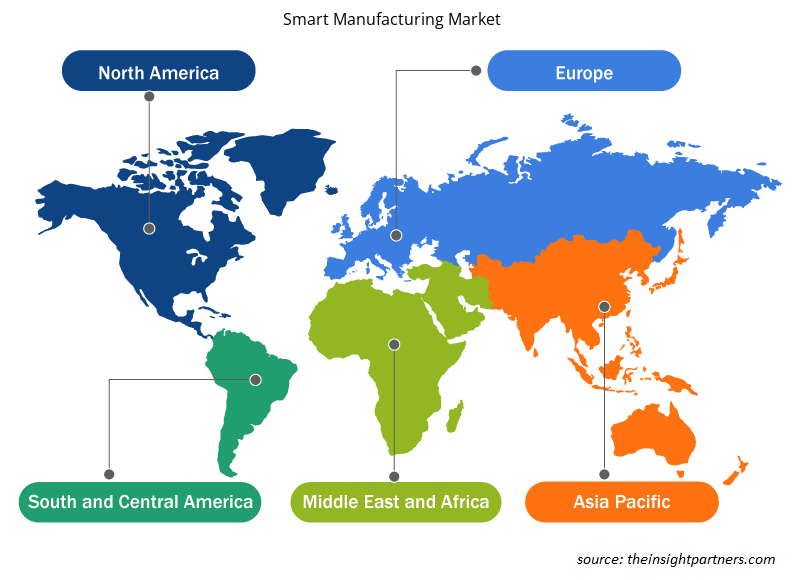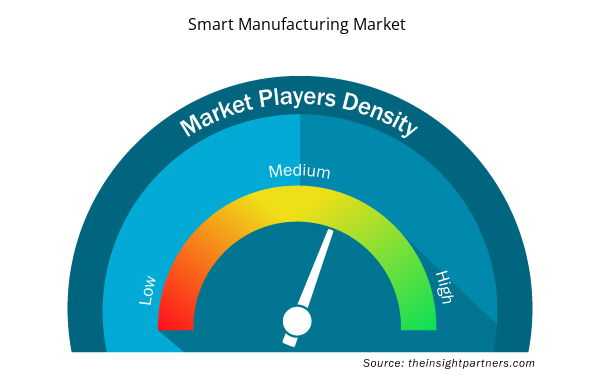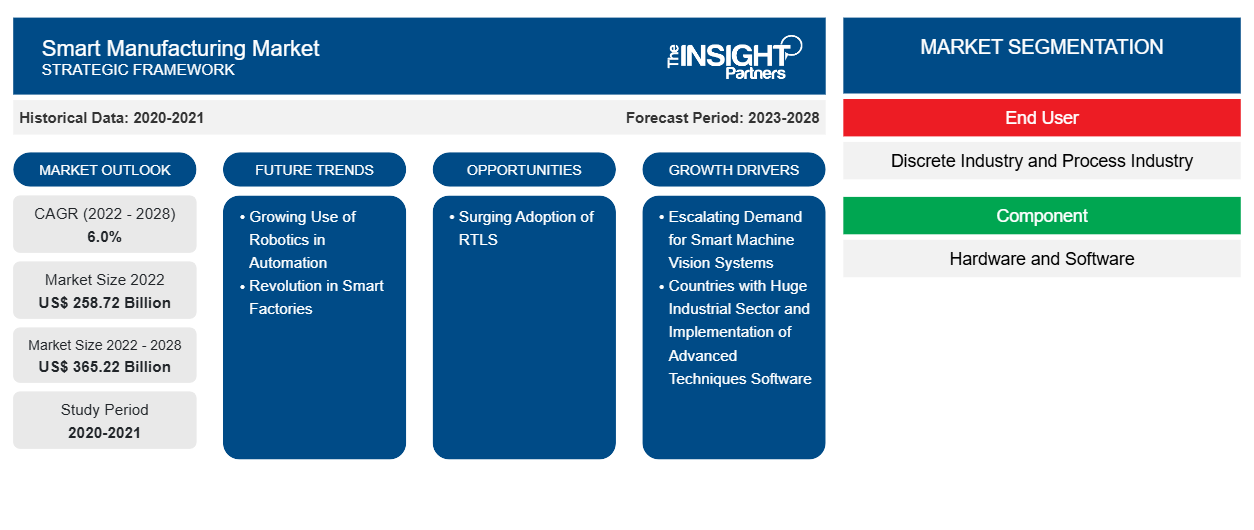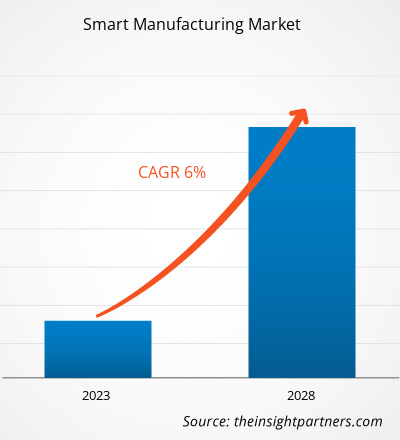[تقرير بحثي] من المتوقع أن ينمو سوق التصنيع الذكي من 249.628 مليار دولار أمريكي في عام 2022 إلى 365.22 مليار دولار أمريكي بحلول عام 2028؛ ومن المتوقع أن ينمو بمعدل نمو سنوي مركب قدره 6.0٪ من عام 2022 إلى عام 2028.
وجهة نظر المحلل:
شهد سوق التصنيع الذكي نموًا وابتكارًا كبيرين في السنوات الأخيرة. يشير التصنيع الذكي، أو الصناعة 4.0 أو الثورة الصناعية الرابعة، إلى دمج التقنيات المتقدمة، مثل الذكاء الاصطناعي (AI)، وإنترنت الأشياء (IoT)، والحوسبة السحابية، وتحليلات البيانات الضخمة ، والروبوتات، في التصنيع. لقد حولت حلول التصنيع الذكي عمليات التصنيع التقليدية من خلال تعزيز الكفاءة والإنتاجية والمرونة. تمكن هذه التقنيات من المراقبة في الوقت الفعلي، والأتمتة، والصيانة التنبؤية، واتخاذ القرارات الذكية، وتحسين مراقبة الجودة، وتقليل وقت التوقف، وتحسين سلاسل التوريد، وتوفير التكاليف. يشمل سوق التصنيع الذكي قطاعات مختلفة، بما في ذلك السيارات، والفضاء، والإلكترونيات، والمستحضرات الصيدلانية، والأغذية والمشروبات، والسلع الاستهلاكية. تبنت صناعة السيارات، على وجه الخصوص، ممارسات التصنيع الذكي لتبسيط الإنتاج، وتعزيز تخصيص المنتج، وتلبية الحاجة المتزايدة للسيارات الكهربائية والقيادة الذاتية. بالإضافة إلى تحسين الكفاءة التشغيلية، يركز التصنيع الذكي على الاستدامة والتأثير البيئي. من خلال تحسين استخدام الموارد، وتقليل النفايات، وتنفيذ ممارسات كفاءة الطاقة، يمكن للمصنعين تقليل بصمتهم الكربونية والمساهمة في التنمية المستدامة. من المتوقع أن ينمو سوق التصنيع الذكي العالمي في السنوات القادمة. تشمل العوامل التي تدفع هذا النمو الطلب المتزايد على الأتمتة، والحاجة إلى تحليلات البيانات في الوقت الفعلي والصيانة التنبؤية ، والاعتماد المتزايد على أجهزة إنترنت الأشياء ومنصات الحوسبة السحابية. علاوة على ذلك، من المتوقع أن تعمل التطورات التكنولوجية مثل اتصال 5G والحوسبة الحافة على تسريع اعتماد حلول التصنيع الذكي.
نظرة عامة على السوق:
يصف مصطلح "التصنيع الذكي" استراتيجية صناعية عالمية تستند إلى تطوير تقنيات وحلول إنتاجية مبتكرة ومتكاملة تم تنفيذها بشكل متزايد في جميع أنحاء العالم. من أجل التحكم الأمثل والقابل للتطوير في عمليات الإنتاج، من الضروري إدخال أنظمة في مصانع التصنيع حيث يتم ربط الآلات باستخدام الإنترنت. تشمل بعض التقنيات المعروفة في التصنيع الذكي إنترنت الأشياء الصناعي (IIoT)، والبلوك تشين في التصنيع، والروبوتات، وأنظمة تخطيط موارد المؤسسات، والصيانة الوقائية، والواقع المعزز والواقع الافتراضي، وتحليلات البيانات، والتعبئة الآلية. لهذا السبب، تواصل المؤسسات الصناعية الاستثمار في وتطوير طرق جديدة لتطبيق هذه التقنيات لزيادة كفاءة الإنتاج. كان هناك أيضًا توسع في الجهود لتعزيز منتجات السوق. يتم إنشاء الجيل التالي من منصات التصنيع الذكي والاتصال بالمصانع الذكية من قبل تحالف من المنظمات الصناعية وموردي التكنولوجيا ومرافق البحث والتطوير والجامعات في الولايات المتحدة والمعروف باسم تحالف قيادة التصنيع الذكي.
قم بتخصيص هذا التقرير ليناسب متطلباتك
ستحصل على تخصيص لأي تقرير - مجانًا - بما في ذلك أجزاء من هذا التقرير، أو تحليل على مستوى الدولة، وحزمة بيانات Excel، بالإضافة إلى الاستفادة من العروض والخصومات الرائعة للشركات الناشئة والجامعات
- احصل على أهم اتجاهات السوق الرئيسية لهذا التقرير.ستتضمن هذه العينة المجانية تحليلاً للبيانات، بدءًا من اتجاهات السوق وحتى التقديرات والتوقعات.
محرك السوق:
زيادة في استخدام الروبوتات الصناعية لتعزيز نمو سوق التصنيع الذكي
مع احتياج المزيد والمزيد من الصناعات إلى الأتمتة، زاد نشر الروبوتات الصناعية. ساهمت الروبوتات الصناعية في نمو السوق بسبب قطاع الإلكترونيات المتوسع وزيادة تكاليف العمالة في التصنيع. ومن المرجح أن يؤدي هذا إلى زيادة الحاجة إلى الروبوتات الصناعية خلال فترة الدراسة، مما قد يدعم نمو السوق في التصنيع الذكي. ونتيجة للتركيز المتزايد على التكنولوجيا الخضراء وكفاءة الطاقة، يمكن للشركات زيادة حصتها في السوق وجذب عملاء جدد من خلال تقديم التصنيع الذكي الذي يستخدم طاقة أقل وأكثر كفاءة في استخدام الطاقة. ومن المتوقع أن تنمو الاستثمارات في الأنظمة الخضراء بمقدار مذهل خلال فترة التنبؤ. يتم استخدام الروبوتات الصناعية بشكل متزايد في صناعة التصنيع لتحسين كفاءة المنتج والإنتاجية والجودة. يمكنهم أداء المهام المتكررة بدقة عالية وسرعة ودقة، مما يساعد على تقليل الأخطاء وتحسين جودة المنتج. كما تقوم الروبوتات أيضًا بالمهام الخطرة أو الصعبة على البشر، على سبيل المثال، العمل في بيئة غير آمنة أو تحريك أشياء ذات حجم كبير. كما يتم تطوير تقنيات جديدة مثل التعلم الآلي والذكاء الاصطناعي وإنترنت الأشياء (IoT) التي تمكن الروبوتات من أن تكون أكثر ذكاءً وفعالية استجابةً للتبني المتزايد للروبوتات الصناعية. تساعد هذه التقنيات في إنشاء جيل جديد من الروبوتات الذكية القادرة على العمل بشكل تعاوني مع البشر والروبوتات الأخرى لإنجاز مهام التصنيع المعقدة. كما يعمل التبني المتزايد للروبوتات الصناعية على دفع توسع سوق التصنيع الذكي من خلال زيادة الطلب على حلول الأتمتة وتحليلات البيانات وغيرها من التقنيات التي يتم استخدامها لتحسين عمليات التصنيع وتحسين جودة المنتج.
التحليل القطاعي:
بناءً على المستخدم النهائي، يتم تقسيم سوق التصنيع الذكي إلى صناعة منفصلة وصناعة العمليات. احتل القطاع المنفصل الحصة الأكبر من السوق في عام 2020 ومن المتوقع أن يسجل أعلى معدل نمو سنوي مركب في السوق خلال فترة التنبؤ. كان للقطاع المنفصل في سوق التصنيع الذكي الحصة الأكبر بسبب الطلب المتزايد على الأتمتة والرقمنة في عمليات التصنيع المنفصلة مثل السيارات والفضاء والدفاع. ساعد تبني تقنيات التصنيع الذكي في هذه الصناعات في تحسين الكفاءة وخفض التكاليف وتعزيز مراقبة الجودة. وقد أدى هذا إلى زيادة الطلب على حلول التصنيع الذكي، مما دفع النمو في القطاع المنفصل من السوق. بالإضافة إلى ذلك، من المتوقع أن يؤدي التركيز المتزايد على الصناعة 4.0 وإنترنت الأشياء الصناعية (IIoT) إلى زيادة النمو في القطاع المنفصل من سوق التصنيع الذكي.
التحليل الإقليمي:
تم تقييم سوق التصنيع الذكي في منطقة آسيا والمحيط الهادئ بـ 78.76 مليار دولار أمريكي في عام 2022 ومن المتوقع أن يصل إلى 111.53 مليون دولار أمريكي بحلول عام 2028؛ ومن المتوقع أن ينمو بمعدل نمو سنوي مركب بنسبة 5.5٪ خلال الفترة المتوقعة. شكلت منطقة آسيا والمحيط الهادئ أكبر حصة في السوق. ومن المتوقع أيضًا أن تشهد المنطقة أسرع نمو خلال الفترة المتوقعة. تسعى الدول النامية مثل الصين والهند إلى الأتمتة الكاملة في التصنيع الذكي نظرًا لوجود العديد من الآفاق غير المستغلة في هذه الأسواق. وبسبب عدة عوامل، أصبحت منطقة آسيا والمحيط الهادئ لاعباً مهيمناً في سوق التصنيع الذكي. أحد الأسباب الرئيسية لهيمنة المنطقة هو الاستثمار الكبير الذي قامت به الحكومات والمنظمات الخاصة في تطوير تقنيات التصنيع المتقدمة. تستثمر دول مثل الصين واليابان وكوريا الجنوبية بكثافة في تطوير تقنيات مثل الروبوتات والذكاء الاصطناعي وإنترنت الأشياء (IoT) لتحسين عمليات التصنيع وزيادة الإنتاجية. بالإضافة إلى استثمارات الحكومة والقطاع الخاص، تتمتع منطقة آسيا والمحيط الهادئ بقوة عاملة واسعة وماهرة ضرورية لتطوير ونشر تقنيات التصنيع المتقدمة. تتمتع المنطقة بتجمع كبير من المهندسين والعلماء والفنيين ذوي المهارات العالية القادرين على تطوير وتنفيذ تقنيات جديدة في قطاع التصنيع. كما تعد منطقة آسيا والمحيط الهادئ موطنًا للعديد من شركات التصنيع الرائدة في العالم، وخاصة في قطاعي الإلكترونيات والسيارات. تستثمر هذه الشركات بكثافة في تطوير تقنيات التصنيع المتقدمة لتحسين الكفاءة وخفض التكاليف وزيادة الإنتاجية. ونتيجة لذلك، أصبحت المنطقة مركزًا للابتكار في قطاع التصنيع، مع تطوير العديد من التقنيات الجديدة واختبارها قبل طرحها عالميًا.
كما أن الطلب المتزايد على المنتجات المخصصة يدفع أيضًا إلى تطوير سوق التصنيع الذكي في منطقة آسيا والمحيط الهادئ. ومع تزايد متطلبات المستهلكين وتوقعهم الحصول على منتجات تلبي احتياجاتهم، يتجه المصنعون إلى التقنيات المتقدمة مثل الطباعة ثلاثية الأبعاد والتعلم الآلي لإنشاء منتجات مخصصة بسرعة وكفاءة. وتتمتع منطقة آسيا والمحيط الهادئ بمكانة جيدة للاستفادة من هذا الاتجاه، حيث يوجد العديد من شركات الطباعة ثلاثية الأبعاد الرائدة في العالم في المنطقة. وأخيرًا، تستفيد منطقة آسيا والمحيط الهادئ أيضًا من التأييد المتزايد للحوسبة السحابية وتحليلات البيانات الضخمة في التصنيع. وتُستخدم هذه التقنيات لجمع وتحليل كميات هائلة من البيانات من مصادر مختلفة، بما في ذلك أجهزة الاستشعار والآلات والأجهزة الأخرى، لتحديد الأنماط والاتجاهات التي يمكن الاستفادة منها لتحسين عمليات التصنيع وجودة المنتج. وتتمتع المنطقة ببنية تحتية كبيرة ومتنامية للحوسبة السحابية، مما يساعد في دفع تبني هذه التقنيات في قطاع التصنيع.
تحليل اللاعب الرئيسي:
يتألف تحليل سوق التصنيع الذكي من لاعبين مثل شركة Yokogawa Electric Corporation؛ وشركة Cisco Systems, Inc؛ وشركة Honeywell International Inc.؛ وشركة 3D Systems, Inc؛ وشركة Daifuku Co., Ltd؛ وشركة GENERAL ELECTRIC؛ وشركة IBM Corporation؛ وشركة Oracle Corporation؛ وشركة Siemens AG؛ وشركة Schneider Electric SE. ومن بين اللاعبين في مجال التصنيع الذكي، تعد شركة Cisco Systems, Inc. وشركة Siemens AG من بين اللاعبين الرئيسيين نظرًا لمجموعة المنتجات المتنوعة التي تقدمها.
رؤى إقليمية حول سوق التصنيع الذكي
لقد قام المحللون في Insight Partners بشرح الاتجاهات والعوامل الإقليمية المؤثرة على سوق التصنيع الذكي طوال فترة التوقعات بشكل شامل. يناقش هذا القسم أيضًا قطاعات سوق التصنيع الذكي والجغرافيا في جميع أنحاء أمريكا الشمالية وأوروبا ومنطقة آسيا والمحيط الهادئ والشرق الأوسط وأفريقيا وأمريكا الجنوبية والوسطى.

- احصل على البيانات الإقليمية المحددة لسوق التصنيع الذكي
نطاق تقرير سوق التصنيع الذكي
| سمة التقرير | تفاصيل |
|---|---|
| حجم السوق في عام 2022 | 258.72 مليار دولار أمريكي |
| حجم السوق بحلول عام 2028 | 365.22 مليار دولار أمريكي |
| معدل النمو السنوي المركب العالمي (2022 - 2028) | 6.0% |
| البيانات التاريخية | 2020-2021 |
| فترة التنبؤ | 2023-2028 |
| القطاعات المغطاة | حسب المستخدم النهائي
|
| المناطق والدول المغطاة | أمريكا الشمالية
|
| قادة السوق وملفات تعريف الشركات الرئيسية |
|
كثافة اللاعبين في سوق التصنيع الذكي: فهم تأثيرها على ديناميكيات الأعمال
يشهد سوق التصنيع الذكي نموًا سريعًا، مدفوعًا بالطلب المتزايد من المستخدم النهائي بسبب عوامل مثل تفضيلات المستهلكين المتطورة والتقدم التكنولوجي والوعي المتزايد بفوائد المنتج. ومع ارتفاع الطلب، تعمل الشركات على توسيع عروضها والابتكار لتلبية احتياجات المستهلكين والاستفادة من الاتجاهات الناشئة، مما يؤدي إلى زيادة نمو السوق.
تشير كثافة اللاعبين في السوق إلى توزيع الشركات أو المؤسسات العاملة في سوق أو صناعة معينة. وهي تشير إلى عدد المنافسين (اللاعبين في السوق) الموجودين في مساحة سوق معينة نسبة إلى حجمها أو قيمتها السوقية الإجمالية.
الشركات الرئيسية العاملة في سوق التصنيع الذكي هي:
- شركة يوكوجاوا للكهرباء
- شركة سيسكو سيستمز
- شركة هونيويل الدولية
- شركة 3D Systems
- شركة دايفوكو المحدودة
إخلاء المسؤولية : الشركات المذكورة أعلاه ليست مرتبة بأي ترتيب معين.

- احصل على نظرة عامة على أهم اللاعبين الرئيسيين في سوق التصنيع الذكي
التطورات الأخيرة:
تتبنى الشركات في سوق التصنيع الذكي بشكل كبير الاستراتيجيات غير العضوية والعضوية مثل عمليات الدمج والاستحواذ. وفيما يلي بعض التطورات الرئيسية الأخيرة في السوق:
- في أكتوبر 2022 - أعلنت شركة ABB أن شركة Accelleron Industries AG، الرائدة في مجال الشواحن التوربينية عالية الطاقة للتطبيقات الحرجة، حصلت على ترخيص لبدء التداول في بورصة SIX السويسرية في زيوريخ تحت الرمز "ACLN". تم ذلك لاستكمال عملية فصل شركة Accelleron عن شركة ABB.
- في يوليو 2022 - أبرمت شركة ABB وشركة SKF مذكرة تفاهم لاستكشاف إمكانيات التعاون في مجال أتمتة عمليات التصنيع. ومن خلال الشراكة، ستحدد الشركتان الحلول اللازمة لتحسين قدرات التصنيع ودعم زيادة كفاءة الإنتاج لدى العملاء وتقييمها.
- التحليل التاريخي (سنتان)، السنة الأساسية، التوقعات (7 سنوات) مع معدل النمو السنوي المركب
- تحليل PEST و SWOT
- حجم السوق والقيمة / الحجم - عالميًا وإقليميًا وقطريًا
- الصناعة والمنافسة
- مجموعة بيانات Excel


- Ceramic Injection Molding Market
- Excimer & Femtosecond Ophthalmic Lasers Market
- Smart Water Metering Market
- Dairy Flavors Market
- Europe Industrial Chillers Market
- Microcatheters Market
- Embolization Devices Market
- Analog-to-Digital Converter Market
- Vessel Monitoring System Market
- Lyophilization Services for Biopharmaceuticals Market

Report Coverage
Revenue forecast, Company Analysis, Industry landscape, Growth factors, and Trends

Segment Covered
This text is related
to segments covered.

Regional Scope
North America, Europe, Asia Pacific, Middle East & Africa, South & Central America

Country Scope
This text is related
to country scope.
الأسئلة الشائعة
APAC is the fastest-growing regional market in the global Smart manufacturing market in 2021.
The global smart manufacturing market was valued at US$ 258.72 Bn in 2022
The Future trends impacting the smart manufacturing market are:
1. 3D robotics
2. AI
3. IoT technologies
The hardware segment led the smart manufacturing in 2021.
US, Germany, India, South Africa, and Brazil are the countries are registering a high growth rate during the forecast period.
The global smart manufacturing market size is projected to reach US$ 365.22 Bn by 2028.
The driving factors impacting the Smart manufacturing market are
1. Surging Adoption of RTLS
2. Increasing Trend of Industry 4.0
The incremental growth of the smart manufacturing market during the forecast period is US$ 22.0 billion with a CAGR of 6.0%
The key players holding the major market share of smart manufacturing are General Electric Company; Honeywell International Inc.; Oracle Corporation; Schneider Electric SE; Siemens AG; Hitachi Ltd; Alstom SA; Irdeto; Raytheon Technologies Corporation; and ENSCO Inc.
The List of Companies - Smart Manufacturing Market
- Yokogawa Electric Corporation
- Cisco Systems, Inc
- Honeywell International Inc.
- 3D Systems, Inc
- Daifuku Co., Ltd
- GENERAL ELECTRIC
- IBM Corporation
- Oracle Corporation
- Siemens AG
- Schneider Electric SE
The Insight Partners performs research in 4 major stages: Data Collection & Secondary Research, Primary Research, Data Analysis and Data Triangulation & Final Review.
- Data Collection and Secondary Research:
As a market research and consulting firm operating from a decade, we have published and advised several client across the globe. First step for any study will start with an assessment of currently available data and insights from existing reports. Further, historical and current market information is collected from Investor Presentations, Annual Reports, SEC Filings, etc., and other information related to company’s performance and market positioning are gathered from Paid Databases (Factiva, Hoovers, and Reuters) and various other publications available in public domain.
Several associations trade associates, technical forums, institutes, societies and organization are accessed to gain technical as well as market related insights through their publications such as research papers, blogs and press releases related to the studies are referred to get cues about the market. Further, white papers, journals, magazines, and other news articles published in last 3 years are scrutinized and analyzed to understand the current market trends.
- Primary Research:
The primarily interview analysis comprise of data obtained from industry participants interview and answers to survey questions gathered by in-house primary team.
For primary research, interviews are conducted with industry experts/CEOs/Marketing Managers/VPs/Subject Matter Experts from both demand and supply side to get a 360-degree view of the market. The primary team conducts several interviews based on the complexity of the markets to understand the various market trends and dynamics which makes research more credible and precise.
A typical research interview fulfils the following functions:
- Provides first-hand information on the market size, market trends, growth trends, competitive landscape, and outlook
- Validates and strengthens in-house secondary research findings
- Develops the analysis team’s expertise and market understanding
Primary research involves email interactions and telephone interviews for each market, category, segment, and sub-segment across geographies. The participants who typically take part in such a process include, but are not limited to:
- Industry participants: VPs, business development managers, market intelligence managers and national sales managers
- Outside experts: Valuation experts, research analysts and key opinion leaders specializing in the electronics and semiconductor industry.
Below is the breakup of our primary respondents by company, designation, and region:

Once we receive the confirmation from primary research sources or primary respondents, we finalize the base year market estimation and forecast the data as per the macroeconomic and microeconomic factors assessed during data collection.
- Data Analysis:
Once data is validated through both secondary as well as primary respondents, we finalize the market estimations by hypothesis formulation and factor analysis at regional and country level.
- Macro-Economic Factor Analysis:
We analyse macroeconomic indicators such the gross domestic product (GDP), increase in the demand for goods and services across industries, technological advancement, regional economic growth, governmental policies, the influence of COVID-19, PEST analysis, and other aspects. This analysis aids in setting benchmarks for various nations/regions and approximating market splits. Additionally, the general trend of the aforementioned components aid in determining the market's development possibilities.
- Country Level Data:
Various factors that are especially aligned to the country are taken into account to determine the market size for a certain area and country, including the presence of vendors, such as headquarters and offices, the country's GDP, demand patterns, and industry growth. To comprehend the market dynamics for the nation, a number of growth variables, inhibitors, application areas, and current market trends are researched. The aforementioned elements aid in determining the country's overall market's growth potential.
- Company Profile:
The “Table of Contents” is formulated by listing and analyzing more than 25 - 30 companies operating in the market ecosystem across geographies. However, we profile only 10 companies as a standard practice in our syndicate reports. These 10 companies comprise leading, emerging, and regional players. Nonetheless, our analysis is not restricted to the 10 listed companies, we also analyze other companies present in the market to develop a holistic view and understand the prevailing trends. The “Company Profiles” section in the report covers key facts, business description, products & services, financial information, SWOT analysis, and key developments. The financial information presented is extracted from the annual reports and official documents of the publicly listed companies. Upon collecting the information for the sections of respective companies, we verify them via various primary sources and then compile the data in respective company profiles. The company level information helps us in deriving the base number as well as in forecasting the market size.
- Developing Base Number:
Aggregation of sales statistics (2020-2022) and macro-economic factor, and other secondary and primary research insights are utilized to arrive at base number and related market shares for 2022. The data gaps are identified in this step and relevant market data is analyzed, collected from paid primary interviews or databases. On finalizing the base year market size, forecasts are developed on the basis of macro-economic, industry and market growth factors and company level analysis.
- Data Triangulation and Final Review:
The market findings and base year market size calculations are validated from supply as well as demand side. Demand side validations are based on macro-economic factor analysis and benchmarks for respective regions and countries. In case of supply side validations, revenues of major companies are estimated (in case not available) based on industry benchmark, approximate number of employees, product portfolio, and primary interviews revenues are gathered. Further revenue from target product/service segment is assessed to avoid overshooting of market statistics. In case of heavy deviations between supply and demand side values, all thes steps are repeated to achieve synchronization.
We follow an iterative model, wherein we share our research findings with Subject Matter Experts (SME’s) and Key Opinion Leaders (KOLs) until consensus view of the market is not formulated – this model negates any drastic deviation in the opinions of experts. Only validated and universally acceptable research findings are quoted in our reports.
We have important check points that we use to validate our research findings – which we call – data triangulation, where we validate the information, we generate from secondary sources with primary interviews and then we re-validate with our internal data bases and Subject matter experts. This comprehensive model enables us to deliver high quality, reliable data in shortest possible time.


 احصل على عينة مجانية لهذا التقرير
احصل على عينة مجانية لهذا التقرير